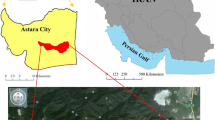Abstract
The great erosion control potential of agroforestry systems is generally recognized. However, insufficient data are available to be able to give absolute quantitative values for the erosion control potential of specific agroforestry systems or to compare their potential. To obtain such quantitative erosion data, long-term standard erosion measurements should be done in specific agroforestry systems. Such measurements may become very costly because the data need to be collected in a wide range of agroforestry systems on different sites over a long time. A further constraint is the reliability of such information: erosion figures may not be comparable because of discrepancy between the scale of measurement and the scale of the agroforestry system and the occurrence of different kinds of erosion. The methodology presented here enables a quick comparative estimation of the erosion (surface erosion, gully erosion and mass movement) control potential of different agroforestry systems. The erosion control value of agroforestry systems is related to their protective functions: the cover, barrier and soil reinforcement functions. The methodology involves identifying which features influence these different functions within a specific agroforestry system and subsequently evaluating the efficacy. The applicability of this methodology is demonstated with examples from various agroforestry systems in the Himalayan region.
Similar content being viewed by others
References
Bannister ME and Nair PKR (1990) Alley cropping as a sustainable agricultural technology for the hillsides of Haiti: experience of an agroforestry outreach project. American Journal of Alternative Agriculture 5(2): 50–59
Borthakur DN, Singh A and Prasad RN (1985) Shifting cultivation in North East India and a strategy for land and water resource management. Beitr Trop Landwirtsch Veterinärmed 23: 147–158
Bregman L (1991) Agroforestry systems in the Himalayan region and their contribution to soil erosion control. Thesis, Section of Silviculture and Forest Ecology, Department of Forestry, Wageningen Agricultural University, The Netherlands
Coppin NJ and Richards IG (1990) Use of vegetation in civil engineering. Construction Industry Research and Information Association, Butterworth, London
Dunsmore JR (1987) Khardep: rural development in the hills of Nepal. Land Resource Study No 36. Land Resources Development Centre, Surbiton, England
Eppink LAAJ (1986) Introduction to erosion, erosion control and soil conservation. Wageningen Agricultural University, The Netherlands (in Dutch)
Gilmour DA (1984) People, forests and erosion: experiences from the Middle Hills of Nepal. In: O'Loughlin CL and Pearce AJ, eds, Symposium on effects of forest land use on erosion and slope stability, 7–11 May, 1984, pp 15–21. Environment and Policy Institute, East-West Center, University of Hawaii, Honolulu, USA
Gray DH and Megahan WF (1981) Forest vegetation removal and slope stability in the Idaho Batholith. Research Paper INT-271. Intermountain Forest and Range Experiment Station, Forest Service, United States Department of Agriculture, USA
Kyuma K and Pairintra (1983) Shifting cultivation: an experiment at Nam Phrom. Northeast Thailand, and its implications for upland farming in the monsoon tropics. Faculty of Agriculture, Kyoto University, Japan
Maharjan MR (1987) Agroforestry in community development. Banko Janakari 1(4): 63–66
Maithani GP, Bahuguna VK and Negi JDS (1986) Natural processes in the redeeming of Garhwal Himalayan wastelands and future strategies for reclamation: a case study. Indian For 112(7): 608–615
Megahan F and King PN (1985) Identification of critical areas on forest lands for control of nonpoint sources of pollution. Environmental Management 9(1): 7–18
Mongi HO and Huxley PA, eds (1979) Soils Research in Agroforestry. International Council for Research in Agroforestry, Nairobi, Kenya
Montsma G (1988) Zooforestry. In: Wiersum KF, ed, Viewpoints on Agroforestry, pp 91–100. Wageningen Agricultural University, The Netherlands
Prasad RN, Singh A and Varma A (1987) Application of research findings for management of land and water resources in Eastern Himalayan Region. ICAR Research Complex for North Eastern Hill Region, Shillong Meghalaya, India
Prichett WL (1979) Properties and Management of Forest Soils. John Wiley and Sons, New York
Raintree JB (1986) Agroforestry pathways for intensification of shifting cultivation. Agroforestry Systems 4: 39–54
Rice RM (1978) The effect of forest management on erosion and sedimentation due to landslides. Proceedings of the Eighth World Forestry Congress, Part 3, pp 319–332. Jakarta, Indonesia
Sanchez PA (1987) Soil productivity and sustainability in agroforestry systems. In: Steppler HA and Nair PKR, eds, Agroforestry: A Decade of Development, pp 205–223. International Council for Research in Agroforestry, Nairobi, Kenya
Seth SK (1981) India and Sri Lanka: Agroforestry. Food and Agriculture Organization of the United Nations, Rome, Italy
Shrivastava MB, Shrivastava M and Lal CB (1988) Grazinglands, causes of their deterioration and improvement in India. Indian J Range Management 9: 1–8
Singh A and Prasad RN (1987) Alternatives to Shifting Cultivation. Indian Council of Agricultural Research, New Delhi, India
Ssekabembe CK (1985) Perspectives on hedgerow intercropping. Agroforestry Systems 3: 339–356
Wiersum KF (1984) Surface erosion under various tropical agroforestry systems. In: O'Loughlin CL and Pearce AJ, eds, Symposium on effects of forest land use on erosion and slope stability 7–11 May, 1984, pp 231–239. Environment and Policy Institute, East-West Center, University of Hawaii, Honolulu, USA
Wiersum KF (1986) Social forestry and agroforestry in India. Report No 456. Rijksinstituut voor Onderzoek in de Bos- en Landschapsbouw ‘De Dorschkamp’, Wageningen, The Netherlands
Wiersum KF (1988) Soil management and nutrient balances in agroforestry. In: Wiersum KF, ed, Viewpoints on Agroforestry, pp 109–126. Wageningen Agricultural University, The Netherlands
Wiersum KF (1991) Soil erosion and conservation in agroforestry systems. In: Avery ME, Cannell MGR and Ong CK, eds, Biological Research in Asian Agroforestry, pp 209–230. Winrock International, South Asia Books, USA
Young A (1984) Evaluation of agroforestry potential in sloping areas. ICRAF Working Paper No 27. International Council for Research in Agroforestry, Nairobi, Kenya
Young A (1987) Soil productivity, soil conservation and land evaluation. Agroforestry Systems 5: 277–291
Young A (1988) Agroforestry in the control of soil erosion by water. Agroforestry Abstracts 1(2/3): 39–48
Author information
Authors and Affiliations
Rights and permissions
About this article
Cite this article
Bregman, L. Comparison of the erosion control potential of agroforestry systems in the Himalayan region. Agroforest Syst 21, 101–116 (1993). https://doi.org/10.1007/BF00705223
Issue Date:
DOI: https://doi.org/10.1007/BF00705223




